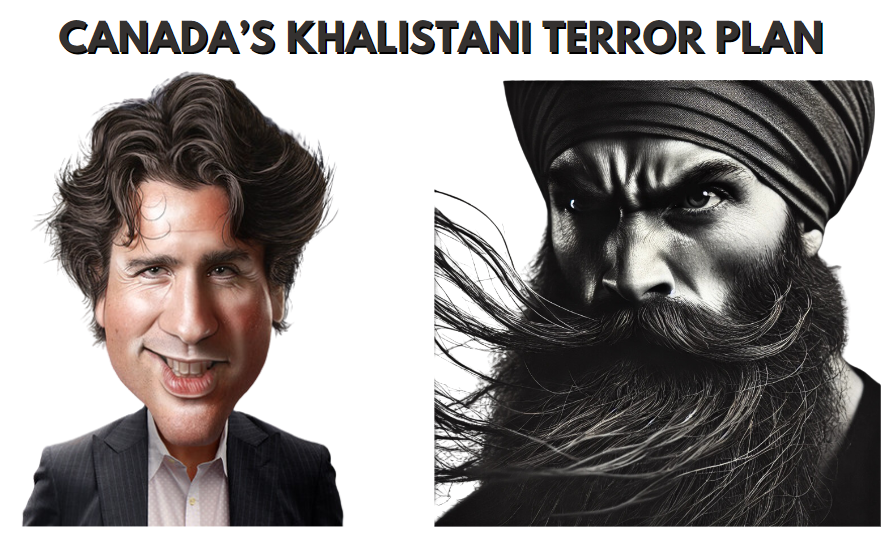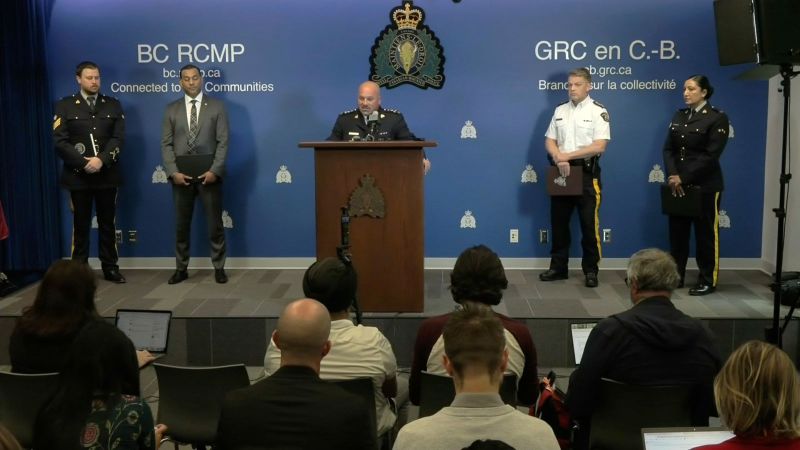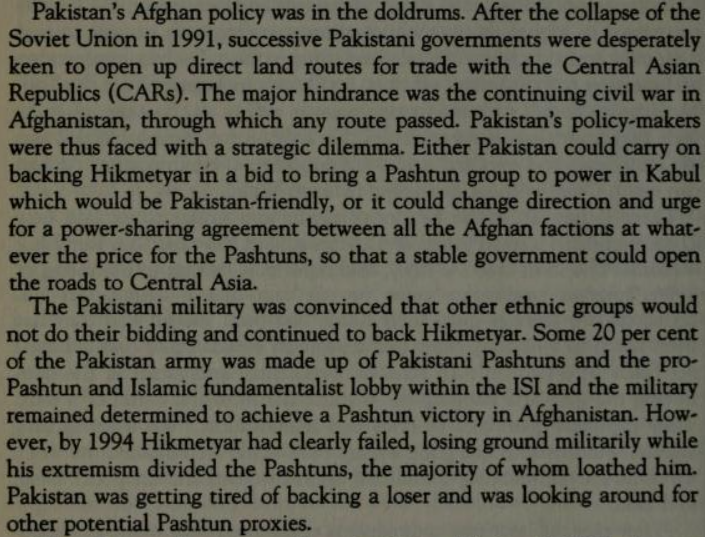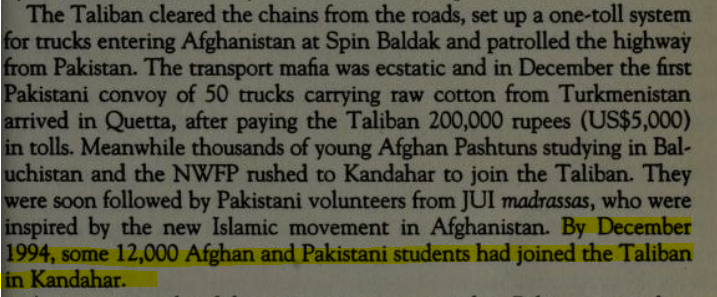How Tariffs, AI, and Robots Will Reshape Industry and Humanity
Tariffs are breaking old trade ties. AI and robots are rewriting the rules. The U.S.–China split is just the beginning of a new world map drawn in algorithms, not alliances.
Canadian Intelligence and political establishment have played Jekyll and Hyde games while using Khalistanis against India. The stories of omission and strategic misses are so spectacular that only collaboration can explain them.


Most Western nations may have physically vacated their colonies decades back, but the exploitation and plunder continued.
Any attempt by a nation or its leaders to stand on their own feet was met with a detailed and ferocious web of terror, violence, and intrigue. Unleashed by the puppets created, facilitated, and protected by these forces.
When Major General Sir Robert Cawthorne - the British Army officer who oversaw the security and intelligence for Pakistan after the independence (yes, the British officers remained in charge in Indian and Pakistan defense post-independence establishments) created the first office of Pakistan's intelligence agency - the ISI - that was built in Karachi, in a building opposite Zainab Market on Old Victoria Street, he gave that intelligence agency a mission.
The large size, in Cawthorne’s assessment, made India weak. And its diversity in religion, languages, castes, etc could be used to make that happen.
Interestingly, Cawthorne was the longest-serving ISI Chief who assisted the first military coup in Pakistan.
What we do takes a lot of work. So, if you like our content and value the work that we are doing, please do consider contributing to our expenses. Choose the USD equivalent amount in your own currency you are comfortable with.
The diplomatic relations between India and Canada have deteriorated significantly over the past few years, reaching a new low in recent months.
Here's a chronological overview of the key events that have led to the current situation:
The roots of the current discord can be traced back to 2018 when a convicted Khalistani terrorist, Jaspal Atwal, was photographed with Canadian Prime Minister Justin Trudeau's wife during their visit to India.

The situation escalated dramatically in 2023:




For all that brouhaha that Trudeau created, the question is - was there any evidence?
Well, let us listen to him discuss that.
So, Trudeau was basically asking the Indian intelligence to find the proof because he had none!
"...at that point it was primarily intelligence and not hard evidentiary proof."
Hmm.. that's mighty convenient!
Well, at that time India swiftly denied these allegations, calling them "absurd and politically motivated". The Indian government took several retaliatory measures:

The situation has continued to worsen:


India stated that it does not trust Canada's judicial system. Just read further and you will know why no one should - not even its own citizens (as they did find out!)
India will withdraw its High Commissioner and diplomats after Canada labeled them 'persons of interest' in a murder investigation. India termed these allegations as baseless and politically motivated. In retaliation, six Canadian diplomats have been expelled. India emphasizes it may take further actions against the Trudeau government's support for extremism. (Source: Economic Times)
Now the whole relationship is worsening.
Prime Minister Trudeau's cavalier approach has contributed to this diplomatic crisis. It has been characterized by:
The Canadian opposition has understood it. They have called out Trudeau's "Conspiracy Theories".
So what is the truth?
Well, things are much worse than they appear. We have discussed them in a video based on publicly available open source information. Please watch this before proceeding ahead.
It is important to understand that we are dealing with dreaded terrorists here. For example, ho was this Nijjar fellow?
Well in this video in Canada during his religious sermon at a Gurudwara, he is openly bragging about assassinating Indira Gandhi, India's ex-PM, its Army Chief, Sikh CM of Punjab as also eulogizing human bombs.
To fully understand the context, let us go into the details of the Khalistani history.
The story of Sikhs in the US and Canada starts way back in the last century.
In the early 1900s, two Sikh gentlemen - Baba Jawala Singh and Baba Wasakha Singh - made their way to California.
They established themselves as prominent figures in the Californian Sikh community, particularly through the founding of the Stockton Gurudwara. It was within this temple's hallowed walls that these visionaries hosted the “Gadri Conclave” in Sacramento, California, laying the foundation for what would become the Ghadar Party. This organization, arguably the first concerted effort by Indians at that time to resist British colonial rule, was a revolutionary endeavor. The spirit of resistance took root in foreign soil, nurtured by the ideals of freedom and democracy they encountered in the United States.
The Stockton Gurdwara was founded in 1912 by Baba Jawala Singh and Baba Wasakha Singh. It was constructed in the early 1900s by the large Indian population that settled in San Joaquin County. This area was chosen for numerous reasons, most notably because it has many similarities to the Punjab region in India. A committee was assembled for the purpose of raising funds to construct a local Gurdwara, and by September of 1912, the land on South Grant Street was purchased. The purchased land already contained a farmhouse, which was converted to serve as the main building. The temple was completed by October, and services were held beginning on October 24, 1912. By 1930, renovations were necessary, and a more modern temple was constructed. The original building is now used as a library. (Source: History: Stockton Gurdwara Sahib / San Joaquin Magazine)
Sardar Kartar Singh Sarabha, arrived in San Francisco on July 28, 1912 in the ship, S.S. Siberia. From there he was taken to the Angel Island for immigration inspection.
He had $100 with him and he told the immigration inspectors that he was planning to study electrical engineering at the Berkeley University (University of California). When asked how he would support himself while in the U.S., he answered that his grandfather, who owned 300 acres of land in India, would send him $40 a month or whatever amount of money he needed to complete his education in the next five years. Impressed with his ability to speak English and his overall appearance, the Board of Special Inquiry admitted him into the country without further questions. He had been detained on Angel Island for only three days. (Source: Student and Revolutionist / Immigrant Voices)
His goal was clear in his mind. He had to work for India's freedom from the clutches of British colonial rule.
While a student at Berkeley, Kartar became involved in the founding of the Gadar (Rebellion) Party and the printing operation of its newspaper, the Hindustan Gadar. Printed in both Urdu, a major language in North India, and in Gurmukhi, the Punjabi script, the newspaper circulated in the Americas, Europe, and East and Southeast Asia, rallying the Indian diaspora to the cause of Indian independence. Known for his passionate speeches, his poetry, and his ability to fire up an audience, Kartar Singh traveled among Indian laborers and farmers to drum up support for the Gadar operations. According to a biography by Bhagat Singh, “He would sit with a worker for hours and explain to him how death is a thousand times preferable to a life of slavery filled with humiliation…. All of them took vows to dedicate their mind, body and wealth for the freedom of their country.” (Source: Student and Revolutionist / Immigrant Voices)
The newspaper became a vital mouthpiece for revolutionary ideas and a call to arms for Indians yearning for independence. Sarabha’s time in the United States shaped his perception of colonialism, fueled by the contradictions he witnessed in America: the juxtaposition of freedom and democracy with the stark realities of racial discrimination.
The infamous Komagata Maru incident in 1914, where a ship carrying Indian immigrants was denied entry into Canada, became a flashpoint that galvanized the Ghadar Party.

Enraged by this blatant discrimination, Sardar Kartar Singh Sarabha returned to India that same year with the intention of organizing an armed uprising against British rule. His bold plans, however, were thwarted, and he was arrested. On November 16, 1915, at the mere age of 19, Sarabha was hanged by British authorities. Yet, his martyrdom ignited a flame of revolution that would inspire future freedom fighters, including the legendary Bhagat Singh.
As the Ghadar Party disbanded in the years following independence, Yuba City emerged as a hub for the Sikh diaspora in California. Many of these revolutionaries, having settled in the region, turned to farming, adapting to the changes in their lives while still holding onto the memories of their revolutionary past. Meanwhile, Sikhs in Canada, also facing harsh discrimination, found themselves navigating similar challenges, such as the forced cutting of their hair and beards, and land acquisition difficulties.

Those who had fought for India's independence were expecting some care from their land of origin.
Initially, Jawaharlal Nehru had expressed concern for overseas Indian communities. In a 1946 speech in Singapore, he stated: "India cannot forget her sons and daughters overseas. Although India cannot defend her children overseas today, the time is soon coming when her arm will be long enough to protect them."However, after independence, Nehru's stance changed significantly:
He not only advised overseas Indian communities to fully identify with their country of residence but even abolished the Ministry for Overseas Indian Affairs in 1947. (Source: India’s Foreign Policy, National Security & Development / Ministry of External Affairs, India)
When Sikhs in the UK faced racial and discrimination issues, the Indian government's response was largely non-interventionist:

Despite their contributions to the nation-building efforts, the post-independence Indian government, particularly under Jawaharlal Nehru, showed little concern for the plight of the Sikhs abroad.
This neglect left the Sikh community feeling abandoned, which, in turn, sowed the seeds of a desire for a separate Sikh state. In the UK, a group of Sikh bus drivers and conductors formed the "Sikh Home Rule" movement, while in the United States, the "United Sikh Appeal" was established, modeled after the "United Jewish Appeal."
It was during this period of growing discontent that Dr. Jagjit Singh Chouhan emerged as a key figure. A seasoned politician in Indian Punjab, Chouhan had served in various capacities, including as Minister of Finance and Deputy Speaker of the Punjab Legislative Assembly. After losing the Punjab Assembly elections in 1969, he relocated to the UK in 1971, where he assumed leadership of the Sikh Home Rule movement. Under his leadership, the movement transformed into what would later be known as the "Khalistan Movement," an advocacy for an independent Sikh homeland.
In 1971, as part of an effort to set up a Sikh government, he visited Pakistan and the United States, where he placed an advertisement in The New York Times proclaiming the formation of Khalistan and collected millions of dollars for it. In India, he was charged with sedition and other crimes in connection with his activities. He became the self-styled president of the “Republic of Khalistan,” appointed a cabinet, issued symbolic passports and postage stamps, and created “Khalistan dollars.” He opened embassies in Britain and other European countries. He remained in close contact with Jarnail Singh Bhindranwale, a violent campaigner for a Sikh theocratic homeland. (Source: Jagjit Singh Chauhan, Sikh Militant Leader in India, Dies at 80 / New York Times)
Chouhan's influence extended beyond the UK's borders. He made a symbolic trip to Nankana Sahib, a revered Sikh site in Pakistan, to establish a Sikh government in exile. His ambitions attracted the attention of the United States, where he was courted by the Nixon administration, which, according to former Indian intelligence officer B. Raman, saw an opportunity to exploit Sikh separatism to weaken Indira Gandhi's government. The United States, working in tandem with Pakistani dictator General Yahya Khan, encouraged Chouhan’s separatist activities as part of a broader strategy of destabilization.
The Richard Nixon administration in the US had initiated a "covert action plan" in collusion with Gen Yahya Khan's government in Pakistan in 1971 to encourage a separatist movement in Punjab, a former top officer of the Research and Analysis Wing (RAW) has said. "This plan envisaged the encouragement of a separatist movement among the Sikhs for an independent state to be called Khalistan. ...In 1971, one saw the beginning of a joint covert operation by the US intelligence community and Pakistan's ISI to create difficulties for India in Punjab," B Raman, who retired as Additional Secretary in the Cabinet Secretariat, says in his forthcoming book. (Source: Economic Times)
Yahya Khan, in a bid to elevate Chouhan’s status among Sikhs, gifted him sacred Sikh relics, thereby bolstering his symbolic leadership. This maneuver was a direct retaliation against Indira Gandhi’s strong stance on the genocide in Bangladesh and the influx of refugees into India.
The then Pakistani military ruler Yahya Khan invited Chauhan to Pakistan, "lionised" him as a leader of Sikhs and handed over some Sikh holy relics kept in Pakistan, which Chauhan took to the UK to win a following in the Sikh diaspora. (Source: 'CIA, ISI encouraged Sikh terrorism' / rediff)
The CIA, in collaboration with Pakistan's ISI, launched a psychological operation (PSYOPS) aimed at highlighting the alleged human rights violations of Sikhs in India. Through these coordinated efforts, Chouhan was presented to the American media as the face of the Khalistan movement, with meetings arranged by Henry Kissinger, then Secretary of State and a key architect of U.S. foreign policy.
During the Nixon Administration in the US, when Dr Henry Kissinger was the National Security Adviser, the intelligence community of the US and the ISI worked in tandem in guiding and assisting the so-called Khalistan movement in Punjab. The visits of prominent Sikh Home Rule personalities to the US before the Bangladesh Liberation War in December, 1971, to counter Indian allegations of violations of the human rights of the Bengalis of East Pakistan through counter-allegations of violations of the human rights of the Sikhs in Punjab were jointly orchestrated by the ISI, the US intelligence and some officials of the US National Security Council (NSC) Secretariat, then headed by Dr Kissinger. This covert collaboration between the ISI and the US intelligence community was also directed at discrediting Mrs Indira Gandhi’s international stature by spreading disinformation about alleged naval base facilities granted by her to the USSR in Vizag and the Andaman & Nicobar, the alleged attachment of KGB advisers to the then Lt Gen Sunderji during Operation Bluestar in the Golden Temple in Amritsar in June, 1984, and so on. (Source: Pakistan's ISI / by B Raman)
A pivotal moment came on October 13, 1971, when a full-page advertisement advocating for Khalistan as an independent Sikh state appeared in The New York Times. Indian intelligence agencies soon uncovered that the advertisement had been paid for by the Pakistani Embassy in Washington, revealing the depth of Pakistani involvement in promoting Sikh separatism. These covert operations continued into the mid-1970s, even as the political landscape in India shifted under the Janata Party government of Morarji Desai.

During this time, the radicalization of Sikh youth in the UK, US, and Canada accelerated, leading to the formation of new organizations such as the International Sikh Youth Federation (ISYF), Dal Khalsa, and Babbar Khalsa. These groups advocated for violent means to achieve their separatist goals, marginalizing figures like Chouhan, who opposed such tactics. Despite his diminished influence, Chouhan continued his Khalistan advocacy, returning to the UK in 1980 to reignite the movement following Indira Gandhi's re-election. His efforts, however, were sidelined by authorities in Pakistan and China, though the United States still found him useful in their geopolitical chessboard, particularly in countering India’s alliance with the USSR.
Simultaneously, another leader, Ganga Singh Dhillon, emerged in the United States. His close personal ties to Pakistani dictator Zia-ul-Haq's family facilitated his frequent visits to Pakistan, where he established the Nankana Sahib Foundation.

Dhillon’s connections further cemented the relationship between Khalistani separatists and Pakistan's military regime.

A dramatic escalation occurred on September 29, 1981, when a Dal Khalsa terrorist, Gajinder Singh, and his accomplices hijacked Indian Airlines Flight 423 to Lahore. This marked the beginning of a series of hijackings orchestrated by Sikh extremists.
What was extremely interesting was that just days before this hijacking, a New York Times journalist had visited the Golden Temple and interviewed Dal Khalsa members, including Gajinder Singh.
The interview was never published! Why? Was the NYT "journalist" meeting Dhillon for an interview really?

Subsequent hijackings followed a disturbing pattern, with Sikh terrorists consistently diverting Indian flights to Lahore, where they would spew anti-India rhetoric and decry the Indian government's alleged mistreatment of Sikhs. In one instance, the Pakistani authorities provided the hijackers with a revolver to replace their toy gun, further demonstrating Pakistan’s complicity in these acts of terror.
They used it to spew venom on India and Indira Gandhi.
Despite clear evidence of Pakistan’s involvement in fomenting Khalistani terrorism, the United States consistently blocked Indian efforts to have Pakistan declared a state sponsor of terrorism. This protection of Pakistan was part of a larger geopolitical strategy, with the U.S. using Pakistan as a proxy to challenge India’s regional dominance. Meanwhile, terrorists from the UK, Canada, and the US continued to travel to Pakistan, where they received training and support.
In response, India’s intelligence agency, R&AW, created a specialized division to monitor the activities of Sikh extremists in the West and their ties to the ISI. Yet, Western intelligence agencies, driven by their own geopolitical interests, continued to stoke the flames of Khalistani terrorism, leaving India to grapple with the consequences of these covert operations.
Thus, the seeds of discord sown by external powers under the guise of geopolitical maneuvers left a lasting impact on the Indian state, with the specter of Khalistani extremism haunting India's political landscape for decades.
It was in this decade of the 1980s that the most dreaded aviation terrorism attack was carried out.
329 people boarding Air India Flight 182, operated by a Boeing 747-237B named "Emperor Kanishka" for their journey that day - June 23, 1985. It departed from Montreal's Mirabel International Airport with London's Heathrow Airport as its intended destination.
But at 07:14 Irish Standard Time, the aircraft suddenly disappeared from radar screens. Subsequent investigations revealed that an explosion had occurred in the forward cargo hold, causing rapid decompression and the break-up of the aircraft structure.
The bombing was meticulously orchestrated by Khalistani Sikh extremists, who had painstakingly planned this devastating act of terror.
The perpetrators, driven by their extremist ideology, spent months carefully crafting the details of their sinister plot. This attack, characterized by its unprecedented complexity and precise coordination, sent shockwaves through the international community.
The meticulous planning and execution of this attack not only highlighted the dangerous capabilities of extremist groups but also exposed significant vulnerabilities in aviation security protocols of the time.
As a result of this conspiracy, a bomb was manufactured, placed in a suitcase, and taken to the Vancouver airport, where on June 22, 1985, it was checked through on a flight from Vancouver to Toronto. In Toronto, the lethal suitcase made its way onboard Air India Flight 181, which then stopped at Mirabel and became Air India Flight 182, en route to London and Delhi. At approximately 12:14 a.m., on June 23, 1985, the timer on the bomb detonated a charge and blew open a hole in the left aft fuselage of the plane. The aircraft, which bore the name 'Kanishka', was blown apart, falling approximately 31,000 feet below into the Atlantic Ocean off the south-west coast of Ireland. (Source: "Lessons to be learned" / Government of Canada)
Shockingly, this wasn't the only act of terror planned for that day. Halfway across the world, a second bomb—intended for Air India Flight 301 departing from Japan's Narita International Airport—detonated prematurely before it could be loaded onto the plane, killing two baggage handlers.
The terrorists' plan failed due to a critical miscalculation: they hadn't accounted for Japan's lack of daylight saving time.

Clearly, the Khalistani terrorists had much larger plans for mass murder than actually transpired.
The intelligence gathered revealed a complex web of conspirators, with Talwinder Singh Parmar emerging as the primary architect of this heinous act.
Working in close collaboration with Parmar was Inderjit Singh Reyat, who played a crucial role in the technical aspects of the bombings. Together, these individuals meticulously orchestrated one of the deadliest terrorist attacks in aviation history, demonstrating a level of planning and coordination that would have far-reaching consequences for international security protocols.

In an extremely chilling revelation, Canadian Security Intelligence Service (CSIS) agents had been actively surveilling Talwinder Singh Parmar, one of the masterminds behind the Air India bombing, in the days leading up to the attack.
This bomb test, conducted in a remote area of British Columbia, involved the detonation of a small explosive inside a vehicle, a precursor to the device that would later be placed on Air India Flight 182.
The CSIS agents witnessed the test!
Despite observing this crucial event, CSIS failed to intervene in a way that could have stopped the plot. The agents were gathering intelligence, yet no preventive measures were taken to disrupt the bombing plan.
This lapse in action has since raised serious questions about how closely Canadian authorities were tracking the group, and why the information they had did not lead to more decisive action.

Disturbingly, intelligence transcripts revealed a deeply concerning aspect of the plot: the terrorists had managed to infiltrate key positions through an insider named Surjan Singh Gill.

This individual, who had been strategically placed within the operation, was unexpectedly withdrawn at the eleventh hour. The sudden removal of this insider, rather than thwarting the plot, clearly points to the complicity of the Canadian intelligence and state apparatus in the killings of the over 200 Canadian citizens..
As a result, the terrorist operation was able to proceed without detection, exploiting the gap left by Gill's abrupt departure.

In this whole plot, there is one man who needs to be understood well. Talwinder Singh Parmar.

Parmar was a key figure in the Khalistani separatist movement and the primary mastermind behind the bombing of Air India Flight 182.
But that wasn't all he was busy with. He was involved in deep terrorist activities.
His involvement in violent activities was well known to Canadian authorities, particularly the Canadian Security Intelligence Service (CSIS), long before the Air India tragedy.
Or was it because of their support?
Let us list some of the things he was involved with based on the article above.
What strikes you the most here?
Despite these known links and the intelligence gathered on Parmar’s activities, CSIS did not act decisively enough to prevent him from carrying out his plans. His ability to travel to Pakistan, train with ISI-supported militants, and return to Canada to orchestrate further terrorist acts represents a massive intelligence failure.
The story of how the trial was orchestrated is an even more interesting one.
Let us look at the acquittal of two of the primary suspects in the Air India Flight 182 bombing: Ajaib Singh Bagri and Ripudaman Singh Malik.
Both were acquitted due to the insufficient evidence presented in court, despite a trove of intelligence pointing to their involvement.
We have factual evidence that there was concrete prior intelligence held by both the Canadian Security Intelligence Service (CSIS) and the Royal Canadian Mounted Police (RCMP).
It was well known to these agencies that Talwinder Singh Parmar and Inderjit Singh Reyat had tested an explosive device 21 days before the bombing, near Duncan, British Columbia.
Now, that's one heck of a hit job on our collective intelligence!
So let us play it back -
Journalists and media keeps chalking it up to "possible operational failures" or "gaps" within Canada’s intelligence and law enforcement apparatus.
Obstruction of justice?

The truth of why the phone tapes had been destroyed was simple. Cover up!
CSIS had erased close to 250 tapes out of an estimated 300 (over 83%!) tapes of Parmar's phone calls! To cover up its own tracks?
And let's not forget Ripudaman Singh's case while we are at it.
These Khalistanis aren't any genteel group of folks. They have a history of hounding their critics.
Anyone who speaks about or against Khalistani terrorism or the perpetrators of the Air India Flight 182 bombing is hounded and threatened.
Not all of these issues should be the focus of an inquiry, because they are very broad, and some are already the subject of widespread public debate. As Justice Josephson determined in his Reasons for Judgment, the conspiracy to bomb the two Air India flights involved individuals belonging to what became known as the Babbar Khalsa movement, a group of Sikh radicals determined to "purify" the Sikh religion and establish an independent homeland for Sikhs in Punjab, India. The families told me that they believe Canada must do more to deal with forces of extremism, even hatred, within communities that have made this country their home. They believe that Canada's politicians have not been sufficiently sensitive to the risks of festering solitudes within communities breaking out into violence. They pointed to the evidence of a culture of fear within communities that has stopped people telling the truth about what happened. Two potential witnesses in the Malik and Bagri trials were killed. These murders, while still under active investigation, have not yet led to criminal charges. Kim Bolan, a reporter with the Vancouver Sun, has written a recent book on Air India that documents many efforts at silencing and intimidating her and others in the Sikh community critical of extremism. In the course of my work I encountered many in the Sikh community deeply troubled by threats of violence, the past misuse of Gurdwaras (temples) for political purposes and the abuse of charitable fundraising for extremist causes. (Source: "Lessons to be learned" / Government of Canada)
Let's get back to the story - the same Ripudaman Singh was assassinated in July 2022.
He was killed in an internecine Khalistani gang battle, where one gang - Nijjar's group - killed him because he had become inconvenient for the ISI handlers.
Ripudaman Singh Mallik, a man with presumably many hats, was assassinated on Thursday, 14 July, in Brampton, Surrey, of Canada. Having earned millions through his Khalsa Credit Union, Ripudaman Singh Malik had actually been accused of being a key figure in the conspiracy behind the Air India Bombings of 1985 as ‘revenge’ for Operation Blue Star. Investigations are on, and there are theories ranging from rival Khalistani elements to Pakistan’s Inter Services Intelligence (ISI) having murdered Malik for ‘betraying’ the Khalistani cause and supporting Indian Prime Minister Narendra Modi-led Bharatiya Janata Party (BJP) in the Punjab assembly elections. After all, Ripudaman had been closely associated with Talwinder Singh Parmar, the alleged mastermind of the Air India bombing. Parmar headed one of the Babbar Khalsa factions before being killed by the Punjab Police in 1992. (Source: "Ripudaman Singh Malik's Assassination Puts The Spotlight Back On Canada's Worst Kept Secret" / Swarajya Mag)
That is a typical modus operandi of the ISI. They brought in the Taliban when Hekmatyar could not deliver goods in the early 1990s.
By 1994, however, The Pakistanis had lost all patience with Hekmatyar because he could not deliver on the promise of uniting the Pashtuns.

The stage was set for the Taliban to emerge now.
On October 29, 1994, a convoy from Pakistan Army’s National Logistics Cell (NLC) left Quetta with 80 Pakistani ex-army drivers. Local commanders, including Mansur Achakzai, stopped and held the convoy near the Kandahar airport.
On November 3rd, the Taliban moved in and not just killed them but hung Mansur’s body for all to see.

So basically a repeat.
All these activities would have needed a lot of financing.
The Air India Report and the Regulation of Charities and Terrorism Financing by Kent Roach / The University of Toronto Law Journal, Vol. 61, No. 1 (Winter 2011), pp. 45-57 (13 pages)
This report by the University of Toronto Law Journal clearly stated that Khalistani terrorists have historically received financial support from the diaspora, particularly in countries like Canada, the United Kingdom, and the United States. Much of this financing has come through charitable organizations set up to do his dirty work in the garb of charity.
British intelligence services have been aware of the activities of Khalistani terrorists on UK soil for decades. The UK has a significant Sikh population, and intelligence reports suggested that most of the fundraising activities for Khalistan were being conducted through Sikh temples and community organizations. Despite this knowledge, the country's intelligence organizations feigned difficulty in taking direct action due to the excuse of the dual nature of these organizations—many provided legitimate religious and community services while also allegedly supporting separatist agendas.
Well, that is interesting because when the law enforcement agencies need to - related to terror crimes - they can raid anyone they want. And all they have to show is that the foundation has terror videos and literature. That is a grave crime.
In December, U.S. authorities raided the Chicago offices of another Saudi-based charity, the Benevolence International Foundation. The foundation's videos and literature glorify martyrdom, and, according to the charity's newsletter, seven of its officers were killed in battle last year in Chechnya and Bosnia. In March 2002, Bosnian officials investigating foreign humanitarian organizations reported funds were missing from the Bosnian office of Benevolence International.6Also in March, Bosnian police raided the offices of an Islamic charity called Bosnian Ideal Future, which is the local name under which Benevolence International operated in Bosnia. Officials seized weapons, plans for making bombs, booby-traps and false passports.7 A day later, the U.S. Embassy in Bosnia was shut down for four days, from March 20-24, after Bosnian officials informed the embassy of a possible threat. According to a Bosnian official, Al-Qa'ida terrorists reportedly met in Sofia, Bulgaria, where they decided that "in Sarajevo something will happen to Americans similar to New York last September."8 Two days before the Embassy reopened, Bosnian police arrested Munib Zahiragic, the head of the local Benevolence office and a former officer in the Bosnian Muslim secret police. (Source: "Charitable Organizations and Terrorist Financing: A War on Terror Status-Check" / Washington Institute)
In the case of Khalistani terrorists - it has another name - "Freedom of Speech".
An HT Article reported that UK-based radical Sikh groups were organizing classes to radicalize Sikh youths, as noted by Indian intelligence agencies. These classes, held at several gurdwaras, teach skills like making improvised explosive devices and promoting separatist ideologies, including the creation of Khalistan. Radical elements were also involved in fundraising for pro-Khalistan groups and use TV channels for anti-India rhetoric. Additionally, they launched an organization that supports this agenda.
The report says some TV channels for Sikhs in UK are controlled by pro-Khalistan radicals. These channels are known for their anti-India tirade. During meetings of the Sikh diaspora on religious and other occasions, funds are collected by radical members of organisations such as the Babbar Khalsa International (BKI), International Sikh Youth Federation, Khalistan Commando Force and Khalistan Zindabad Force and are sent to intermediaries based in Punjab and Pakistan, the report added. (Source: "Classes to radicalise Sikh youths being held in UK: Intel agencies" / Hindustan Times)
I could not get for you the link to the article "The CIA and India" by Jules Stewart, which was published in Asian Affairs in 2007, but I have the summary of that article.
One of the most significant revelations in the article is the CIA's support for the Khalistan movement, a Sikh separatist group that sought to establish an independent homeland in the Punjab region of India. Stewart notes that the CIA provided financial and military support to the movement, which was seen as a way to destabilize the Indian government and promote US interests in the region. The article concludes by noting that the CIA's activities in India have often been marked by controversy and secrecy and that the agency's legacy in the country remains complex and contested. Stewart argues that the CIA's involvement in India highlights the need for greater transparency and accountability in intelligence operations and for a more nuanced understanding of the complex relationships between intelligence agencies, governments, and civil society.

India has been sharing its concerns and details of these activities with the three countries - the US, UK and Canada for many decades now.
A detailed dossier on Sikh radicalisation in the UK was shared with the British authorities by India on Thursday. Prime Minister Narendra Modi is on a three-day visit to the UK. Sources said India pressed for action again these groups who are working towards breathing a fresh lease of life to the movement for a separate state within Punjab. The dossier names some gurdwaras in the UK where classes have been held to radicalise youth and impart terror training. (Source: Intelligence says many UK Gurdwaras breeding ultras: India shares dossier with Cameron's government during Modi's visit that states some Sikh organisations are funding Khalistani terror groups / Daily Mail)
But throughout that time, as it is today, these countries and their officials have brushed them aside.
Because - terrorism against India does not impact them.

And that is the bottomline.
Khalistan was a tool to weaponize India's religious minority to work India's faultlines and create interference, even break it.
It was used against Indira Gandhi as a way to "discipline her" by Richard Nixon and Kissinger.
Now, it is being used by the current US, UK, and Canadian establishments to "discipline Modi."
Religious Terrorism has been used by the Western Intelligence agencies to attack other countries and "keep them in check".

The seeds for the weaponization of Sikhism were sowed long back by the British. It is instructive to read that history in detail.

It is a time for reflection where all of us need to look deeper into the events and the motivations behind them.
For, the next target could be you.